The Irrawaddy River is 1350 miles long and runs the full length of Myanmar, and as the great civilisations of Myanmar’s past rose and fell by the banks of this magnificent river, surely the best way to explore this largely unknown country is to do so by boat.
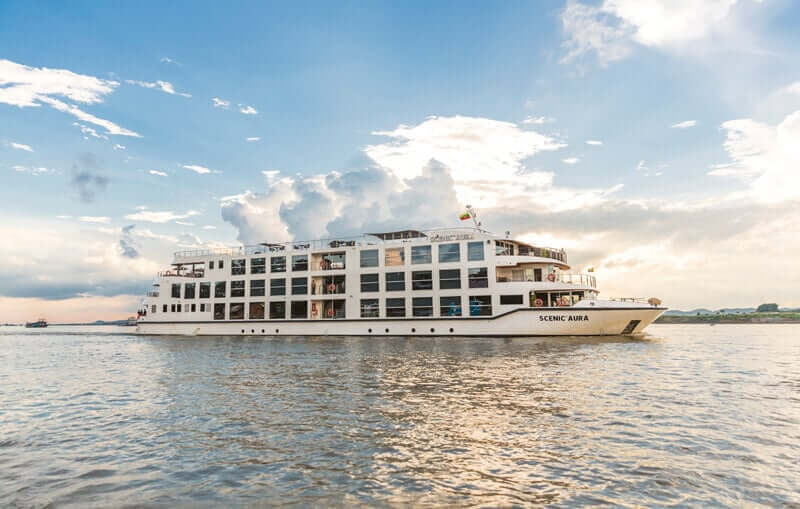 Our starting point for this cruise is Yangon, formerly Rangoon. We arrive from the UK on a very warm Sunday afternoon in January. We only have an hour so before we meet our tour guides for the trip to Mandalay and are briefed on what to expect for the next couple of weeks. There are just 38 guests and because 26 are going on to Inle Lake after Mandalay we are divided into two groups, each with our own tour guide. We are only 12 in number and our guide is a very entertaining young man called Sai Sam.
Our starting point for this cruise is Yangon, formerly Rangoon. We arrive from the UK on a very warm Sunday afternoon in January. We only have an hour so before we meet our tour guides for the trip to Mandalay and are briefed on what to expect for the next couple of weeks. There are just 38 guests and because 26 are going on to Inle Lake after Mandalay we are divided into two groups, each with our own tour guide. We are only 12 in number and our guide is a very entertaining young man called Sai Sam.
After briefing Sai Sam informs us that from 6pm it is happy hour in the Club lounge on the top floor of the hotel and as Scenic guests are in ‘Club’ rooms we make our way to get to know our fellow passengers a little better and enjoy spectacular views over Yangon as the sun goes down.
Dinner on our first evening is at the Strand Hotel. Built in 1901 it flourished in the early 20th century, visited by the likes of Somerset Maugham, Rudyard Kipling and H.G.Wells. In the post-colonial years it fell into disrepair but was restored in 1989 and it was a wonderfully evocative start to our stay in Myanmar.
The following day dawns bright and beautiful. I won’t have to mention the weather again as for the next two weeks we never see a cloud and the day temperature is a steady 30°C with little or no humidity. We have a full day in Yangon with several choices of activity. Eight of us opt for a ferry across the Yangon River to Dhala village, where we are taken on a tour by trishaws. 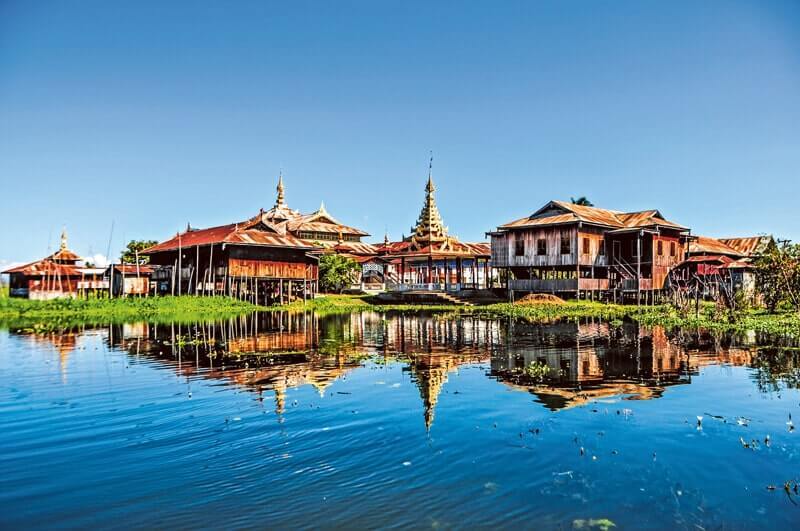 These are bicycles with a sidecar, not the most comfortable mode of transport but novel to say the least. Two days previously we were in London and are now suddenly exposed to such a culture shock that it literally took my breath away. Only half a mile away is the bustling city of Yangon and on the other side of the river we enter a world that hasn’t changed through generations, watching the skills of people using the most basic equipment to eke out a living, skills that we will see demonstrated again and again as we start our journey up the Irrawaddy. By the time we make our way back to the ferry we are exhausted, so many images to be taken in; again, something that we will experience on a daily basis as we make our way to Mandalay.
These are bicycles with a sidecar, not the most comfortable mode of transport but novel to say the least. Two days previously we were in London and are now suddenly exposed to such a culture shock that it literally took my breath away. Only half a mile away is the bustling city of Yangon and on the other side of the river we enter a world that hasn’t changed through generations, watching the skills of people using the most basic equipment to eke out a living, skills that we will see demonstrated again and again as we start our journey up the Irrawaddy. By the time we make our way back to the ferry we are exhausted, so many images to be taken in; again, something that we will experience on a daily basis as we make our way to Mandalay.
The whole group meet up for lunch at the Rangoon Tea Room where we have the best samosas I have ever tasted, then a short bus ride to the Shwedagon Pagoda, the most sacred religious building in the country, with a golden spire 112 metres high that can be seen from all over Yangon. It is the first of many encounters with pagodas over the next few days but they are all so extraordinary, so individually beautiful that the problem is finding words to describe them. The main gold plated dome is topped by a stupa containing 7000 diamonds, rubies, topaz and sapphires, the whole concoction offset by a massive emerald positioned to reflect the rays of the setting sun. It is customary for mendicants, families and followers of Buddha to make the pilgrimage to the Shwedagon in the same way that Muslims feel compelled to visit the Kaaba at Mecca at least once in their lifetime.
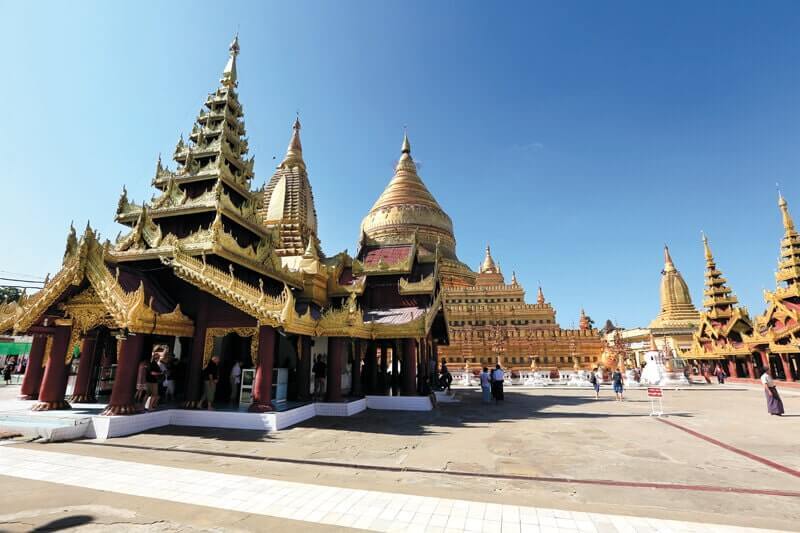 It is here that Sai Sam tells us what our birth animal is, based on which of the Buddhist 8 days of the week we were born. I am a Rat, Babs an Elephant. Around the pagoda there are eight places of worship, Monday corner, Tuesday corner, Wednesday morning corner and Wednesday afternoon corner (to make up the eight), and…well you get the idea. We are sent off by Sai to find our corners. Eventually, after an exhilarating but exhausting first day in Myanmar we are driven back to the hotel where a few of us take advantage of ‘happy hour’ to have several glasses of wine and something to eat before heading to our rooms to pack for a very early start for the long drive to pick up our boat at Prome.
It is here that Sai Sam tells us what our birth animal is, based on which of the Buddhist 8 days of the week we were born. I am a Rat, Babs an Elephant. Around the pagoda there are eight places of worship, Monday corner, Tuesday corner, Wednesday morning corner and Wednesday afternoon corner (to make up the eight), and…well you get the idea. We are sent off by Sai to find our corners. Eventually, after an exhilarating but exhausting first day in Myanmar we are driven back to the hotel where a few of us take advantage of ‘happy hour’ to have several glasses of wine and something to eat before heading to our rooms to pack for a very early start for the long drive to pick up our boat at Prome.
Because the lower reaches of the Irrawaddy are quite shallow in January we are going to join the ship in Pyay, some 6 hours by road from Yangon. It sounds a daunting prospect, and I believe that next Scenic sailing season this journey will be made by plane but in fact it turns out to be an absorbing experience. The coach is very comfortable and gazing out of the windows as we travel through the countryside and small towns is as good a way as any to get a feel of Myanmar. En route we stop at the very impressive Taukkyan War Cemetery with over six thousand graves of Allied soldiers who died in Burma during the second World War and 52 from WW1.
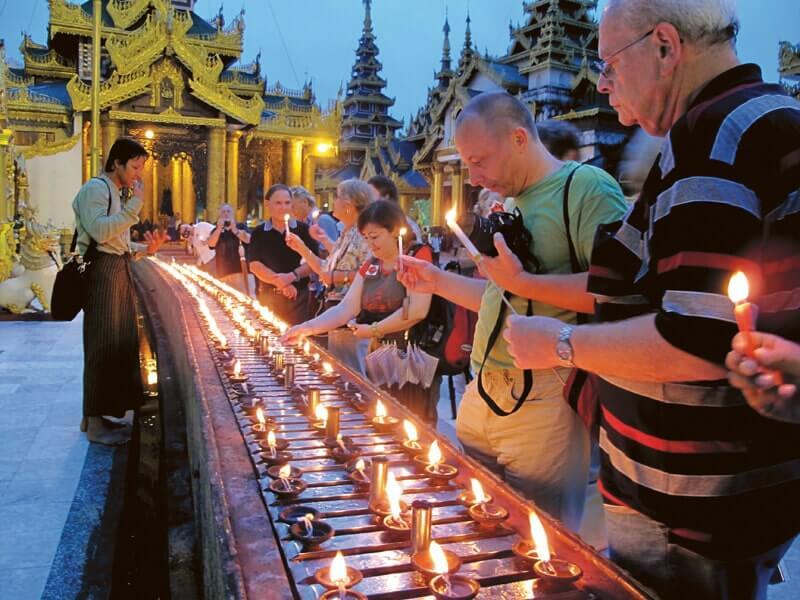 As the days pass it crosses my mind that this trip could be marketed as a gourmet cruise in its own right. The food is exceptional.
As the days pass it crosses my mind that this trip could be marketed as a gourmet cruise in its own right. The food is exceptional.
It has been a very long day and we look forward to a good night’s sleep. We are not disappointed. The suite is immaculate, the bed very comfortable and the pillows superb. I hope I find something not to like tomorrow, otherwise I will run out of superlatives.
The next day we meet up with our tour director Sai Sam and set off to visit central Pyay and the impressive Shwesandaw Pagoda, another important Buddhist pilgrimage site. Before we return to the ship we are driven to Sri Ksetra, Myanmar’s first Heritage-listed site. The museum there is packed with maps and artifacts, with Buddha images dating back as far as the 6th century, which helps to make sense of the excavation sites.
Back on board just before lunch we set sail to Thayetmyo. A gloriously warm and sunny afternoon is spent on the sun deck watching the banks of the river slip by, with the occasional pagoda dome rising above the forests beyond the sand. Makeshift small bamboo shelters are scattered on the sandbanks with fishermen taking advantage of the seasonal low water levels.
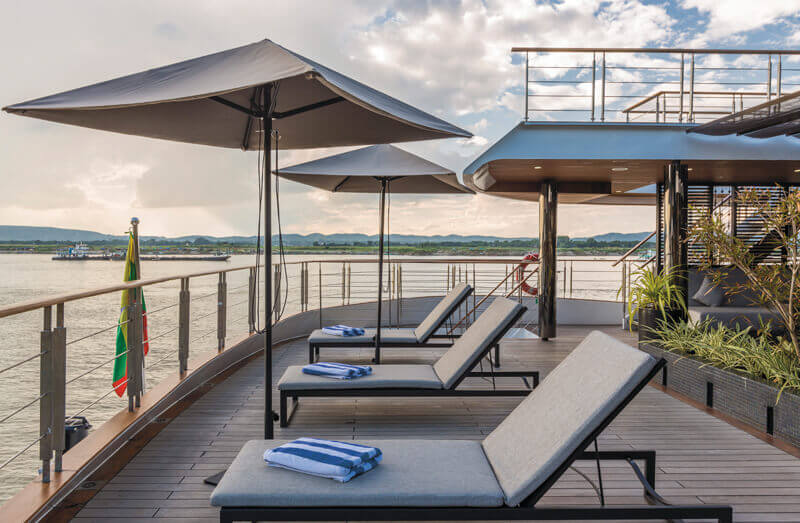 Our revery is broken by an invitation from Sai Sam to have the origin of the national dress explained with a demonstration of the way men and women wear the longyi. This is the ankle length skirt almost universally worn in Myanmar. Believe me it is quite tricky to learn the knack, resulting in some very inelegant results particularly from yours truly. It proved to be a very humorous demonstration.
Our revery is broken by an invitation from Sai Sam to have the origin of the national dress explained with a demonstration of the way men and women wear the longyi. This is the ankle length skirt almost universally worn in Myanmar. Believe me it is quite tricky to learn the knack, resulting in some very inelegant results particularly from yours truly. It proved to be a very humorous demonstration.
A cocktail before dinner as the sun set, another very elegant meal with wine to match, a nightcap with friends in the Mandalay lounge and another day is over.
A quite bizarre excursion awaits us the following day. We are taken by horse and cart (2 to a cart) to Thayet Golf Club, the oldest golf club in Myanmar (1887) and affiliated to St.Andrews. We hold a putting competition on the 18th green and getting down in 4 from 15 feet is cheered to the skies. Back in the horse and cart again from the golf course to a local market, passing on the way many colonial homes built during the British colonisation.
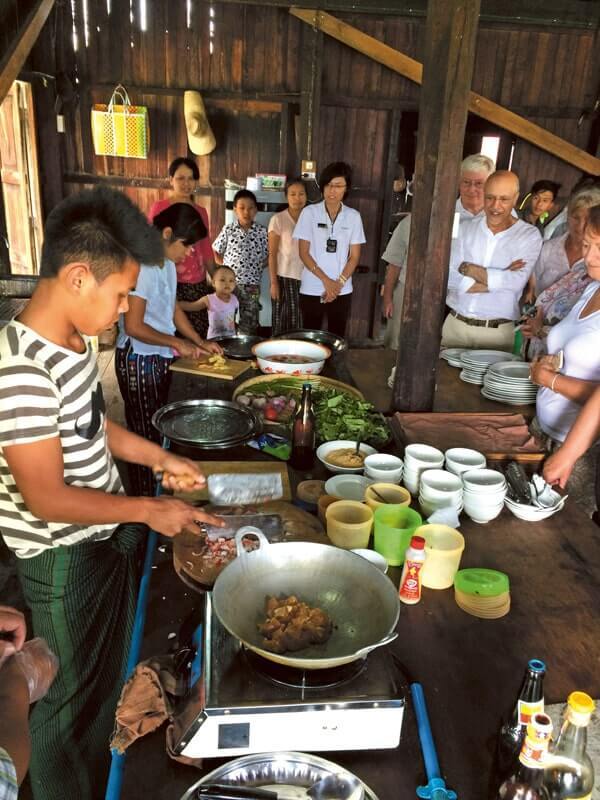 Empires in Burma rose and fell over the centuries until the British colonisation at the end of three Anglo-Burmese wars in the nineteenth century. Although Burma prospered economically resentment of the British was high and there were both peaceful protests and violent riots. During World War II Burma was devastated and some 250,000 civilians killed. At the end of the war General Aung San negotiated Burma’s independence creating a unified state, but he was assassinated by a military coup in 1947 and one of the world’s most closed societies was created. After a 2010 free election the government has made a number of reforms to direct the country towards a liberal democracy but progress is slow and it still has a long way to go.
Empires in Burma rose and fell over the centuries until the British colonisation at the end of three Anglo-Burmese wars in the nineteenth century. Although Burma prospered economically resentment of the British was high and there were both peaceful protests and violent riots. During World War II Burma was devastated and some 250,000 civilians killed. At the end of the war General Aung San negotiated Burma’s independence creating a unified state, but he was assassinated by a military coup in 1947 and one of the world’s most closed societies was created. After a 2010 free election the government has made a number of reforms to direct the country towards a liberal democracy but progress is slow and it still has a long way to go.
Back to the ship, setting sail to Magwe mid-morning and another post lunch prospect of an afternoon on the river, interrupted delightfully by a demonstration of how to make a tea leaf and ginger salad. One never stops learning. Another beautiful sunset, (they are never less than beautiful on the Irrawaddy) another cocktail, another dinner and tonight we have a movie trivia quiz in the Mandalay Lounge. Our team of 6 wins and very few of the other guests suggest that I should be handicapped. Well if they do they do it very discreetly.
Next morning we head off to explore Magwe by trishaw and we visit Mya Tha Lun Pagoda, stunningly located overlooking the Irrawaddy. We almost have the site to ourselves as there are so few tourists away from the cities. There seems little point in comparing one pagoda with another as they are all beautiful, each one unique, but the location of Mya Tha Lun sets it apart.
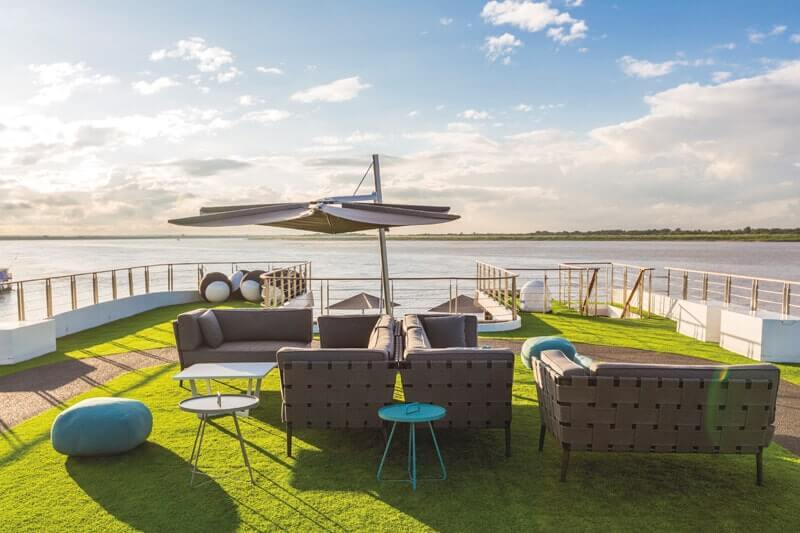 Back to the ship, as we sail for Salay at 11am, then a leisurely lunch and a very peaceful afternoon on the sundeck, reading a book in the shade as we head up river. At tea time there is a very entertaining fashion show of traditional Burmese clothing modelled by members of the crew, then cocktails, dinner, nightcap, sleep. We could very easily get used to this.
Back to the ship, as we sail for Salay at 11am, then a leisurely lunch and a very peaceful afternoon on the sundeck, reading a book in the shade as we head up river. At tea time there is a very entertaining fashion show of traditional Burmese clothing modelled by members of the crew, then cocktails, dinner, nightcap, sleep. We could very easily get used to this.
In the morning we set off on foot to explore Salay, a 13th century village with Bagan era shrines, beautiful 19th century teak monasteries and preserved British colonial buildings. It is hard to describe the feeling of being a tourist but without any other tourists. For the most part just 12 of us explore the village ignored by the people who live here, apart from the occasional dazzling smile or a high five from a passing child.
There is a wonderful teak monastery, Yoke Soun Kyaung Taw Gyi, now a fascinating museum. It is surrounded by crumbling Bagan era monuments. After an utterly absorbing morning we sail to Bagan.
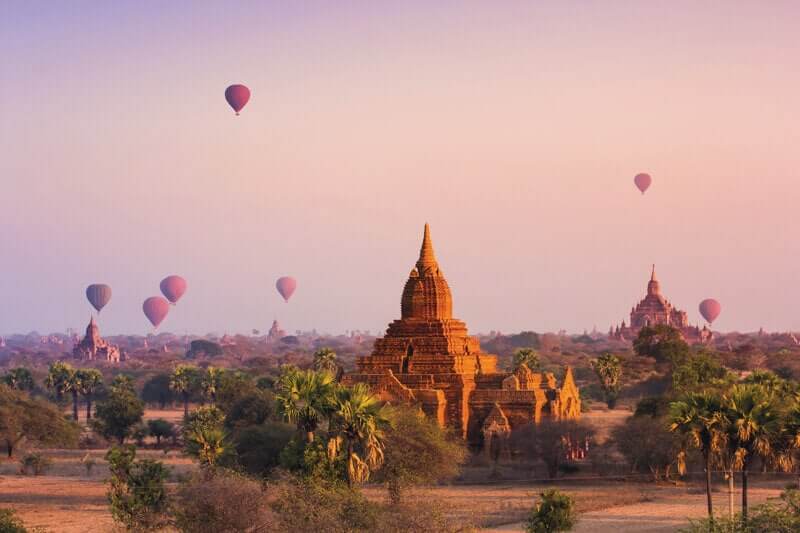 After lunch we begin to see the temples on the river banks and on the hills, partly hidden by trees, as we approach this extraordinary city. There are many lost cities in Myanmar but none approach the splendour of Bagan. Scattered across an arid plain in a bend of the Irrawaddy are the ruins of around 2000 monasteries, temples, shrines and stupas, remnants of an imperial capital that reached its peak between the 11th and 13th centuries. Marco Polo described its gilded skyline as “one of the finest sights in the world.”
After lunch we begin to see the temples on the river banks and on the hills, partly hidden by trees, as we approach this extraordinary city. There are many lost cities in Myanmar but none approach the splendour of Bagan. Scattered across an arid plain in a bend of the Irrawaddy are the ruins of around 2000 monasteries, temples, shrines and stupas, remnants of an imperial capital that reached its peak between the 11th and 13th centuries. Marco Polo described its gilded skyline as “one of the finest sights in the world.”
For the first time since we left Pyay we find ourselves not the only visitors as we moor up on the beach. We have to be ferried from our spot to where we can walk up to get a bus into town. We visit the Ananda Temple, built in 1105 in the form of a Greek cross with a statue of Buddah, 9.5 metres high, at each corner. It is very beautiful.
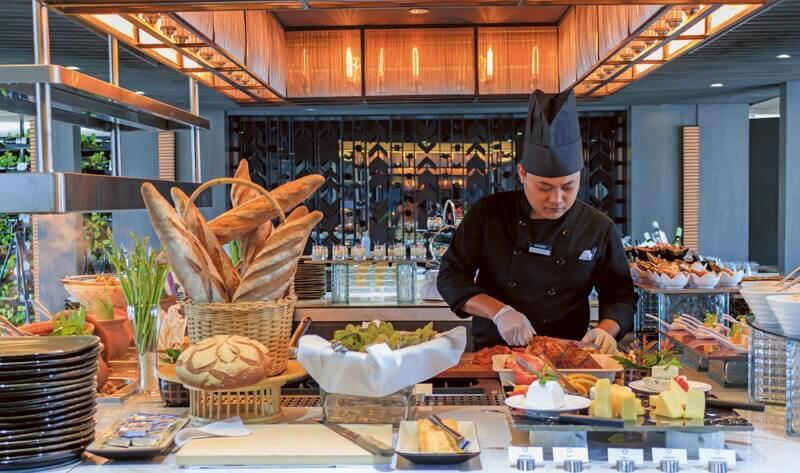 This evening after dinner we are treated to a string puppet show on the sundeck. Great fun, but uppermost in our minds is a very early start in the morning (5am) because a few of us have seized the opportunity to take a balloon ride over Bagan. It is better to fly in the still air of early morning but the exhilarating sight of the sun rising as we float over thousands of temples, pagodas and stupas makes the trip unforgettable. There are maybe twenty large balloons in the air at once, itself a thrilling sight. But this is only the beginning of an extraordinary day. We grab a coffee back on the ship and then we set of to Mount Popa.
This evening after dinner we are treated to a string puppet show on the sundeck. Great fun, but uppermost in our minds is a very early start in the morning (5am) because a few of us have seized the opportunity to take a balloon ride over Bagan. It is better to fly in the still air of early morning but the exhilarating sight of the sun rising as we float over thousands of temples, pagodas and stupas makes the trip unforgettable. There are maybe twenty large balloons in the air at once, itself a thrilling sight. But this is only the beginning of an extraordinary day. We grab a coffee back on the ship and then we set of to Mount Popa.
Mount Popa is a volcano 1518 metres above sea level and is said to be home to the 37 most powerful spirits (nats) of Myanmar. The monastery of Taung Kalat, a complex of stupas and shrines, is perched on the summit of Popa’s southern flank and we have been given the choice of climbing the 800 steps to the monastery where there is a tremendous view or having a pre-lunch drink at a resort on a hill overlooking Mount Popa. We opt for the climb, forgetting that as it is a religious site this has to be done in bare feet! Not only that, but we encounter numerous monkeys on the way up so what is already a tough exercise becomes an obstacle climb as we avoid pee and poo. 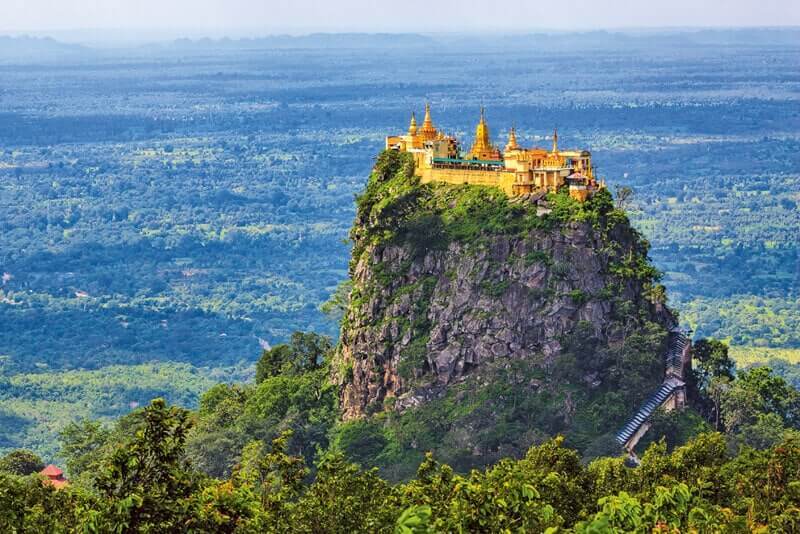 To be fair, at intervals there are monks attempting the Sisyphean task of keeping the steps clean. The view at the top is good but whether it justifies the effort required. We eventually join the pre-lunch drinkers at the resort wondering whether we made the right choice but after a beer and great food sore feet are forgotten, and it’s back to Bagan where we climb onto horse-drawn carts for a tour of the temples we had seen from the air 10 hours previously. Trotting down country lanes with golden pagodas and stupas of all shapes and sizes around every corner was an unforgettable end to a day that had already provided several unique experiences. Cocktails, dinner, nightcap and finally, exhausted, bed.
To be fair, at intervals there are monks attempting the Sisyphean task of keeping the steps clean. The view at the top is good but whether it justifies the effort required. We eventually join the pre-lunch drinkers at the resort wondering whether we made the right choice but after a beer and great food sore feet are forgotten, and it’s back to Bagan where we climb onto horse-drawn carts for a tour of the temples we had seen from the air 10 hours previously. Trotting down country lanes with golden pagodas and stupas of all shapes and sizes around every corner was an unforgettable end to a day that had already provided several unique experiences. Cocktails, dinner, nightcap and finally, exhausted, bed.
After breakfast the next day, before we leave Bagan we visit Pakkoku, transported there by tuktuk. There is a huge market, selling household goods, fresh meat, fish and vegetables and just about every spice and herb under the sun. We could have spent hours there but sadly had to leave with just the memory of some wonderful aromas.
At mid-day we sail for Yandabo and after another delicious lunch, Papa, one of our tour guides gives a lecture on Myanmar, past, present and future. This is our third cruise with Scenic and thanks to our very bright tour guides I’ve ended up much better informed about the places we’ve visited. Politically it is not easy to sing the praises of Myanmar thanks to the recent oppressive regime but Papa, herself Burmese, managed to fill in some of the gaps not covered by western news reports.
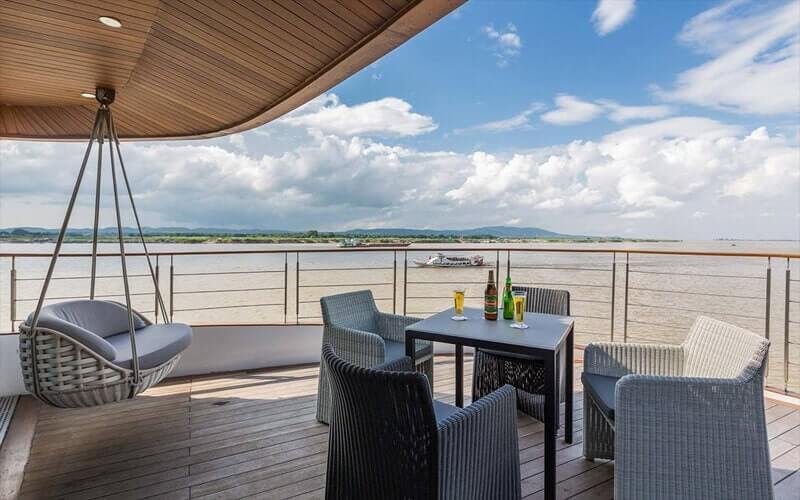 Later in the afternoon we put in, if that’s not an inappropriate term, at a sandbank! While the crew set about organising a bar-b-que on the beach, we were all equipped with kites, and a very entertaining series of kite fights takes place with the crew showing themselves to be considerably more adept than the guests, the number of flightless kites growing by the minute. The battle is called off thanks to the setting of the sun, the lighting of a fire and the arrival of alcohol on the beach followed quickly by food. Because our sandbank is attached to the shore we are eventually joined by a local band and the sight of a ship tied up to a beach on which 50 people are having a party in the middle of the Irrawaddy has to be seen to be believed. It is an extraordinary night.
Later in the afternoon we put in, if that’s not an inappropriate term, at a sandbank! While the crew set about organising a bar-b-que on the beach, we were all equipped with kites, and a very entertaining series of kite fights takes place with the crew showing themselves to be considerably more adept than the guests, the number of flightless kites growing by the minute. The battle is called off thanks to the setting of the sun, the lighting of a fire and the arrival of alcohol on the beach followed quickly by food. Because our sandbank is attached to the shore we are eventually joined by a local band and the sight of a ship tied up to a beach on which 50 people are having a party in the middle of the Irrawaddy has to be seen to be believed. It is an extraordinary night.
Next morning we walk into Yandabo, where the peace treaty of the first Anglo-Burmese War was signed. Now it is a picturesque village famous for its pottery. We stroll through and witness the making and firing of the pots. Up to 3000 pots in a single layer can be covered with a large pile of ash, straw and wood then set on fire. The temperature in this kiln reaches 1200°C and takes 3 or 4 days to cool down, by which time the pots have changed colour from a dull brown to a brilliant red. Back on board Aura we set sail for Sagaing. After lunch, another glorious afternoon relaxing on the sundeck looking forward to a special Burmese dinner, the only potential cloud on the horizon being the request that as we are eating Burmese we should dress Burmese and don the longyis with which we have been provided. Amazingly the skirts defy gravity and there are no embarrassing mishaps. The food, needless to say is wonderful.
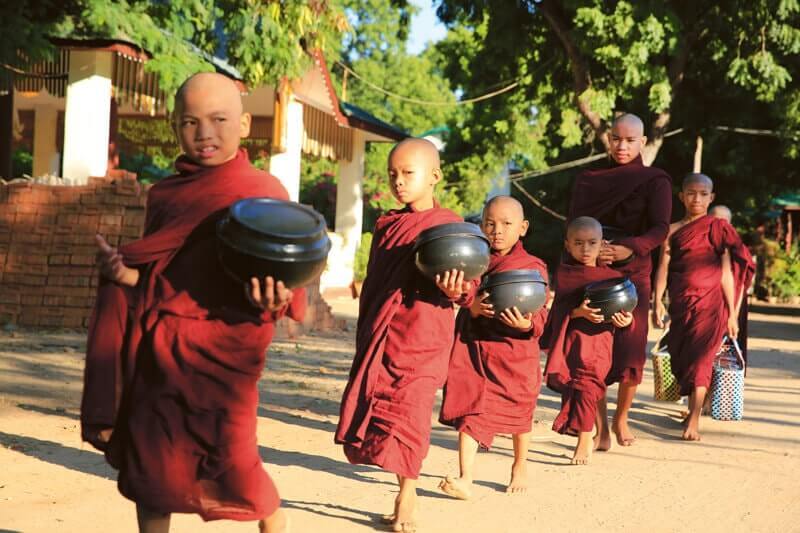 The following day we are up early to see the dozens of white and gold pagodas rising out of the mist on the hills as we approach Sagaing. Today we are visiting a monastic supported school to meet novice monks, nuns and orphans. We arrive to find the children waiting to greet us, which they do by singing a song. Within minutes they have us singing along with them, much to their delight, and they encourage us to sing a song to them. Some of the more extravert of our fellow guests suggest the hokey cokey and the sight of these very young children putting their left legs in and shaking them all about as they attempt to mirror the somewhat elderly movement of the Scenic guests brings tears to the eyes. An utterly delightful half hour followed by a visit to a nunnery to make donations courtesy of Scenic. Altogether a lovely morning.
The following day we are up early to see the dozens of white and gold pagodas rising out of the mist on the hills as we approach Sagaing. Today we are visiting a monastic supported school to meet novice monks, nuns and orphans. We arrive to find the children waiting to greet us, which they do by singing a song. Within minutes they have us singing along with them, much to their delight, and they encourage us to sing a song to them. Some of the more extravert of our fellow guests suggest the hokey cokey and the sight of these very young children putting their left legs in and shaking them all about as they attempt to mirror the somewhat elderly movement of the Scenic guests brings tears to the eyes. An utterly delightful half hour followed by a visit to a nunnery to make donations courtesy of Scenic. Altogether a lovely morning.
After lunch we take local horse carts for a tour of Inwa, an ancient imperial capital that although hit by an earthquake in 1839 still retains evocative temples, stupas and monasteries. It is a magical ride down narrow lanes with magnificent buildings on either side.
Before dinner we have another quiz on board, this time testing our knowledge of Myanmar. I’m afraid this time the team don’t do so well despite me thinking that I had absorbed the Niagara of information that has come our way over the previous ten days.
The following day we have a walking tour of the small town of Mingun. Here we find King Bodawpaya’s uncompleted stupa. Apparently while it was being built the king’s astrologer told him that he would die upon completion of the temple. Work was immediately halted. Had it been finished it would have been the largest in the world. It’s still pretty impressive thanks to the huge cracks in it, a result of the 1839 earthquake. A little further on our walk we come to the Mingun Bell, the heaviest bell in the world, 5 metres wide at the base. Some of our party stand inside the bell as it is rung. I decline the invitation. Further on is the white painted Hsinbyume Pagoda which looks like a giant wedding cake. I can’t help thinking where else in the world can one encounter three such extraordinary sights in the course of an hour’s stroll in a very small town.
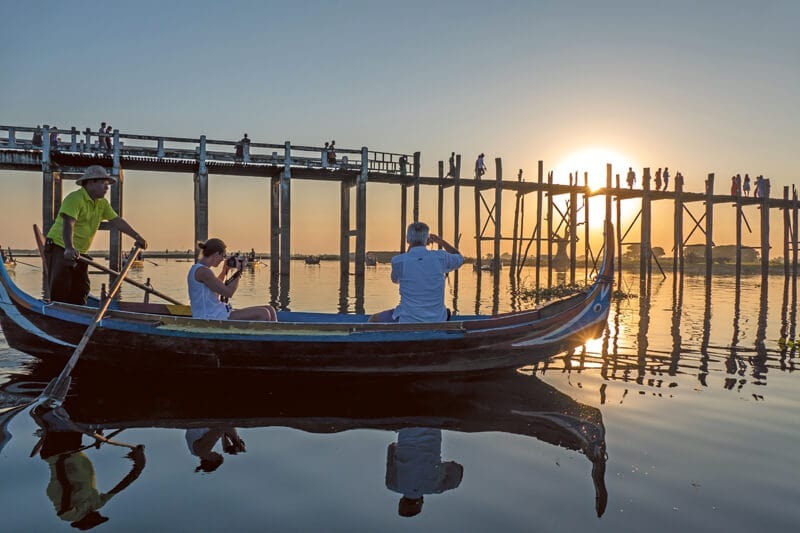 At mid-day we set sail for Mandalay, for us our final destination. Just 3 hours later, after lunch, we make our final excursion off the ship. We are going to Amarapura, on the southwest fringes of Mandalay to visit marble and silk workshops. The intricacy of the woven silk fabrics they produce by hand is wonderful to see, but next door are the mechanical looms and the noise is difficult to take for more than few moments. Out into the relative peace of a bustling city and onto our coach to drive to U-Bein Bridge, reputed to be the world’s longest and oldest teak bridge. There, two at a time we climb into sampans to be taken on a leisurely cruise of the lake and wait for the sun to set. This is one of the only truly tourist events that we have encountered during our stay in Myanmar. The silhouette of the bridge, with Lowry type figures walking along it and the sun setting behind really defies description. As they say, you had to be there. Just when we are thinking it can’t get better a sampan with some of our crew members draws up alongside in the middle of the lake and hands us two glasses of Champagne. It had got better.
At mid-day we set sail for Mandalay, for us our final destination. Just 3 hours later, after lunch, we make our final excursion off the ship. We are going to Amarapura, on the southwest fringes of Mandalay to visit marble and silk workshops. The intricacy of the woven silk fabrics they produce by hand is wonderful to see, but next door are the mechanical looms and the noise is difficult to take for more than few moments. Out into the relative peace of a bustling city and onto our coach to drive to U-Bein Bridge, reputed to be the world’s longest and oldest teak bridge. There, two at a time we climb into sampans to be taken on a leisurely cruise of the lake and wait for the sun to set. This is one of the only truly tourist events that we have encountered during our stay in Myanmar. The silhouette of the bridge, with Lowry type figures walking along it and the sun setting behind really defies description. As they say, you had to be there. Just when we are thinking it can’t get better a sampan with some of our crew members draws up alongside in the middle of the lake and hands us two glasses of Champagne. It had got better.
That evening we have a farewell dinner on board and have an early night, as our luggage has to be outside the suite by 6.30 and after breakfast we disembark the Scenic Aura. A sad farewell to a fabulously charming and helpful crew.
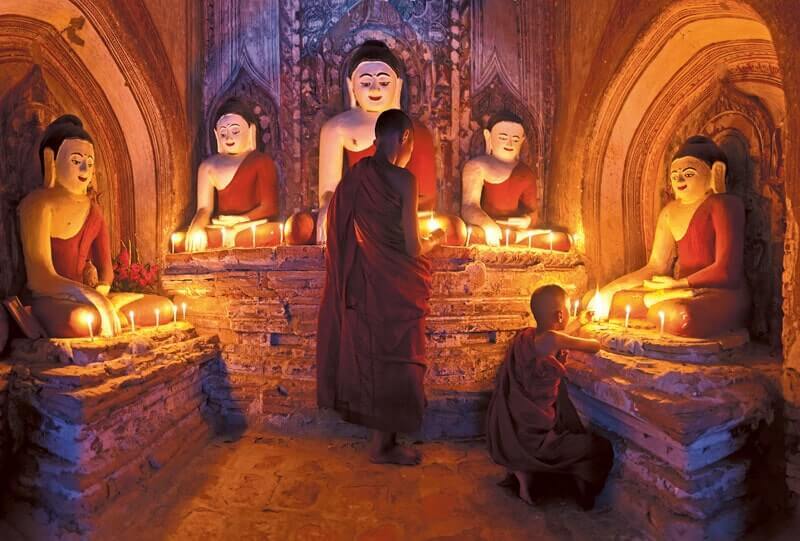 However before we check in at our hotel in the afternoon we have just one day to discover what Mandalay has to offer. Our first call is to the Kuthodaw Pagoda nicknamed “the biggest book in the world”. The central stupa is surrounded by 729 marble slabs on which are engraved the lines of the Buddhist scriptures known as the Tripitaka. Reading that from beginning to end would be quite a challenge, so we move on to Shwenandaw monastery, a beautiful wooden building, each pillar being made from a single teak trunk. Its interior is covered in gold leaf. Which brings us to our next destination, a local workshop where we learn how to make gold leaf. Well you never know when it might come in handy!
However before we check in at our hotel in the afternoon we have just one day to discover what Mandalay has to offer. Our first call is to the Kuthodaw Pagoda nicknamed “the biggest book in the world”. The central stupa is surrounded by 729 marble slabs on which are engraved the lines of the Buddhist scriptures known as the Tripitaka. Reading that from beginning to end would be quite a challenge, so we move on to Shwenandaw monastery, a beautiful wooden building, each pillar being made from a single teak trunk. Its interior is covered in gold leaf. Which brings us to our next destination, a local workshop where we learn how to make gold leaf. Well you never know when it might come in handy!
Next stop is the Mahamuni Pagoda, the most highly revered Buddha image in the country. It may have been cast in the first century and with a height of 4 metres the bronze statue is covered in gold leaf to a depth of 15 centimetres. That is 6 inches thick! This is continually applied by the faithful to pay their respect—men only, as women are not allowed to approach the figure. As you can imagine all this gold has completed distorted the shape of the original image. Each day at 4am the monks wash Mahamuni’s face and brush his teeth.
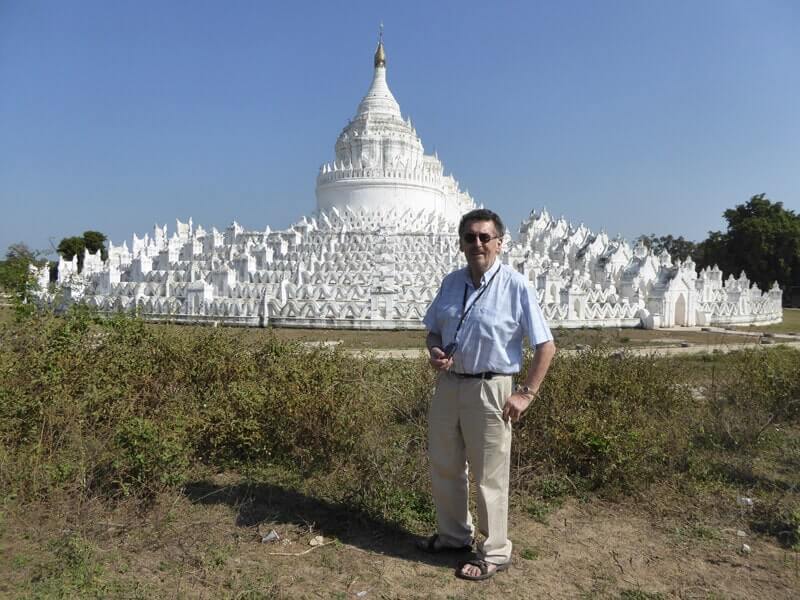 It is time to check in at our hotel before we set off on our last expedition. We are staying at the Mandalay Hill Resort, a splendid hotel at the foot of the sacred Mandalay Hill which although it is only 230 metres high we ascend in minibuses. Well, it has been a long day. The hill is studded with pagodas and temples and the view from the top as the sun sets over the battlements of the palace, the city, the Irrawaddy and the rice-growing plain is wonderful, a fitting end to an extraordinary journey.
It is time to check in at our hotel before we set off on our last expedition. We are staying at the Mandalay Hill Resort, a splendid hotel at the foot of the sacred Mandalay Hill which although it is only 230 metres high we ascend in minibuses. Well, it has been a long day. The hill is studded with pagodas and temples and the view from the top as the sun sets over the battlements of the palace, the city, the Irrawaddy and the rice-growing plain is wonderful, a fitting end to an extraordinary journey.
We have a farewell dinner at the hotel in an excellent Chinese restaurant, a farewell drink with friends we have made and then we go to bed. All the other guests are leaving in the morning, some going on to Inle for a couple of days, the rest flying home. Babs and I are not flying until the following day, so we head to the pool, find a shady spot and spend a very peaceful few hours with our books; a well-earned rest as we prepare to fly home via Bangkok and Dubai.
It has been 16 days that we will never forget.
Silver Travel Advisor recommends Scenic.











